URUGUAYAN AIR FORCE DEPLOYS A-37B JETS TO HIGHWAYS


As a geographically compact nation with small armed forces, Uruguayan military doctrine emphasises in having a well trained, volunteer professional workforce (no military service is available) to maximise utilisation of its limited equipment and material resources. Therefore if attacked by a more powerful foe, the country’s services defensive plan is to strike back in small “packs”, attempting to cause maximum attrition to the enemy, whilst awaiting assistance from a friendly nation. Therefore, as part of the Fuerza Aérea Uruguaya – FAU (Uruguayan Air Force) Annual Activity Plan, deployments to operate their Cessna A-37B Dragonfly attack jets, from remote, small countryside aerodromes and highways – far from their main base – is of paramount importance.

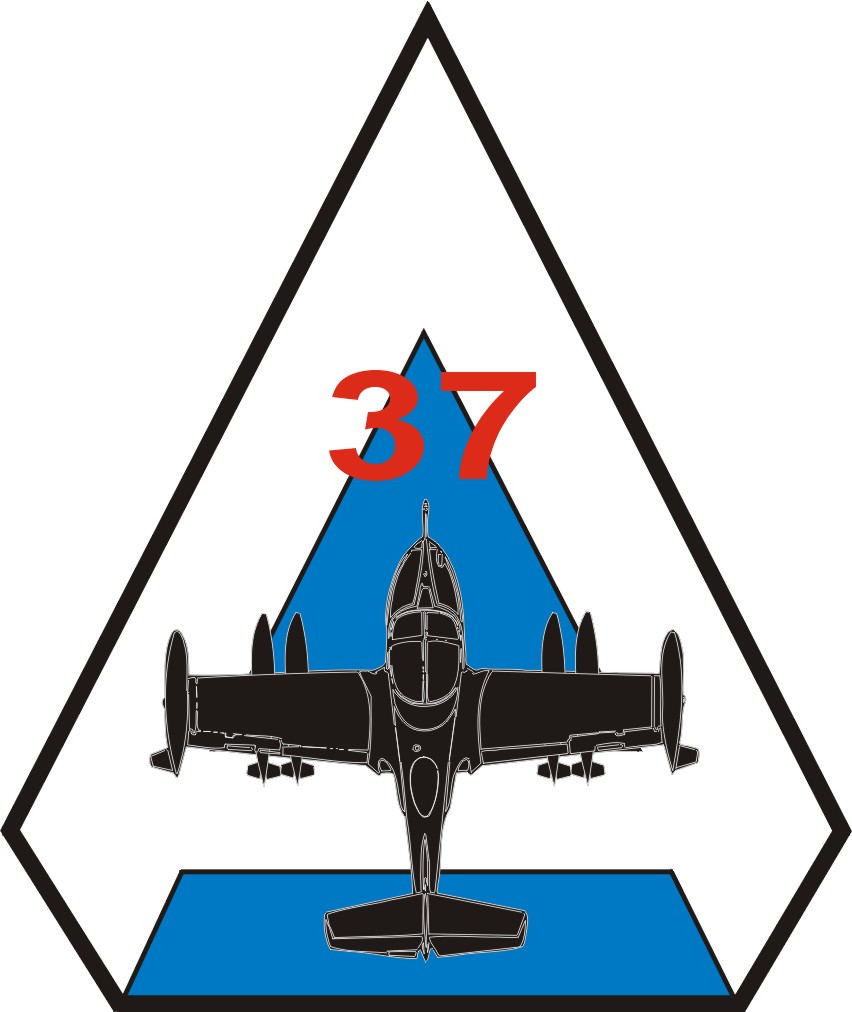
Strickers on the highway

The aircraft – the main tool of air power of this small South American nation – are attached to the Escuadrón Aéreo No. 2 (caza) (Air Squadron No. 2/Fighters) based on Tte. 2do. Mario Walter Parallada Air Base, Brigada Aérea No. 2 (Air Brigade No. 2) located near the town of Durazno in central Uruguay, 100nm (188km) north of the capital Montevideo
The birth of the Dragonfly (AKA Super Tweet!)
The Cessna model 318E, started life as the A-37A, a derivative of the US Air Force T-37A/B/C “Tweet” twin engined jet trainer in service with the US Air Force since 1955. With the requirement during the early days of the Vietnam War, for a more advanced Close Air Support (CAS), light attack, Counter Insurgency (COIN) aircraft by the US Air Force, the prototype YA-37D was created as a “beefed up” T-37 in 1964. Before placing orders for the Cessna jet, the US Air Force wanted to test the aircraft at war, and their losses of ageing Douglas A1 Skyraider (also in service with the Republic of Vietnam Air Force) expedited its adoption – now designated A-37A Dragonfly – to start operations in Vietnam in early 1967. Pilots called the aircraft Super Tweet and amongst its qualities, observed deficiencies like a lack of range, endurance and the heavy to operate – during an attack run – flight controls system as well as having no redundancy in case of damage. An improved version was launched in September 1967 as the A-37B, with a stronger airframe (pulling +6G was possible), eight under wing fuel/armament stations and more powerful General Electric J-85-17A turbojets engines. The 2850lb thrust engines were fitted canted down and outboard as to improve performance during single engine flying (US pilots in Vietnam often increased the jet’s time on station, by shutting down one engine!). Fuel capacity was increased to the self sealing fuel tanks and an inflight refuelling nose fitted probe (also a handy single-point ground refuelling port), a GAU-2B 7.62×51 Minigun, and a large ordenance carrying capacity in relation to the aircraft weight together with good target hit accuracy, made the small, slow a jet a good solution for the tasks it was designed to do. Under 600 Dragonfly were built and the jet became an export success, especially to Latin American nations. With the end of the Vietnam War, Uruguay acquired in 1976, a fleet of eight brand new A-37B aircraft (registered as FAU 270-277) and flown from Wichita, Kansas (USA) to Montevideo by Uruguayan pilots. Five aircraft were lost, four to two inflight collisions during 1983 (FAU 272/271) and 1987 (FAU 270/276) and FAU 283 during 2004. Replacements did arrived from the US on January 23, 1988 (FAU 278/279) March 18, 1989 (FAU 280-285) and FAU 286/287/288 from the Fuerza Aérea Ecuatoriana (Ecuadorian Air Force- FAE) on September 2014.

Our observed highway deployment was carried out from November 6-10, 2017 to the Ruta Nacional No.9 (National Road No.9) running parallel to the Atlantic Ocean in the eastern province of Rocha; a short distance of 15nm (28Km) from the Brazilian border. At the 306km marker of this road (306 km east of downtown Montevideo) there is a 6500ft (2000m) stretch marked as RWY 03-21. A wide circular section at either end of the “runway” is available for the aircraft to operate, back track and to park. The selected Dragonfly were FAU 279 (43304, c/n 70-1289 in service since January 23, 1988) and 282 (43267, c/n 69-6422 in service since March 18, 1989) with the squadron lead by its then Commander Major (Av.) Richard Bruno. Seventy staff members were deployed, ten Dragonfly pilots alongside another ten officers and 30 non-commission officers in charge of maintenance, refuelling, communications, logistics, firefighting and security. Support for the transportation of equipment and personnel was supplied – on the first and last day of the deployment – by a FAU’s EADS /CASA C-212 Aviocar from Escuadrón Aéreo No. 3 (transporte) (Air Squadron No.3 – transport) based at Montevideo’s Brigada Aérea No. 1 (Air Brigade No. 1). Liaison duties were carried out by Cessna C-206H from the Escuadrilla de Enlace (Liaison Squadrille) from Brigada Aérea No.3, located at Boiso Lanza Air Base – FAU Headquarters – north of Montevideo.

Highway closures
Three missions a day were completed and the assistance of the Policía Nacional de Tránsito (National Transit Police) during ground operations, was invaluable; as they would block the road to passing cars, motorist and observers for approximately 15 minutes. To ensure a safe operation, squadron personnel would conduct a road sweep by car, inspecting it for presence of debris (Foreign Object Damage – FOD) after every take off and landing. The ATC services were carried out from a hut positioned parallel to the road, with the VHF equipment supplied by the FAU’s Servicio de Comunicación e Informática (Communication and IT Service). While airborne the aircraft were under the umbrella of the FAU’s Centro de Operaciones Aéreas (COA – Air Operations Centre/AOC) located at Boiso Lanza Air Base in Montevideo.


The AOC utilises data received from two ARSR-3D (M) Lanza radars built by Indra Sistemas of Spain. A mobile one is positioned around the country as required and a fixed one located at Santa Clara de Olimar, Treinta y Tres province, northwest of Rocha. This state of the art system, part of the FAU’s Sistema de Vigilancia y Control del Espacio Aéreo (Air Control and Surveillance System) can communicate and transmit data (including meteorological information) via HF/GPRS and fibre optics; assisted by the installation of eight communications relay stations across the country. Digital datalink is unavailable on the old Dragonflies.
Mission details

Missions lasted for approximately one hour each, starting with low level navigation (below 1000ft) and 240 knots towards nearby designated fixed ground targets. This speed makes for easier VFR navigation, being also a self restriction applied for bird strike/windscreen limits protection. In war time, speeds of 300 knots would more appropriate, with a maximum tactical navigation speed of 340 knots.

Simulated attacks and Close Air Support (CAS) missions were conducted alongside the Ejército Nacional Uruguayo (Uruguayan National Army). Its Batallón de Infantería Mecanizada No. 12 (Mechanised Infantry Battalion No.12) based in the nearby city of Rocha, deployed to an area 4nm (7km) west of the seaside port town of La Paloma (52nm/97km west of the Ruta 9 operational runway area) where the army performed qualifications of armoured vehicles employment to 41 non commission officers. The unit utilised their AVGP (Armoured Vehicle General Purpose) MOWAG Grizzly (a Canadian built vehicle, based on the Swiss Piranha I) which become apt targets for the Dragonfly.
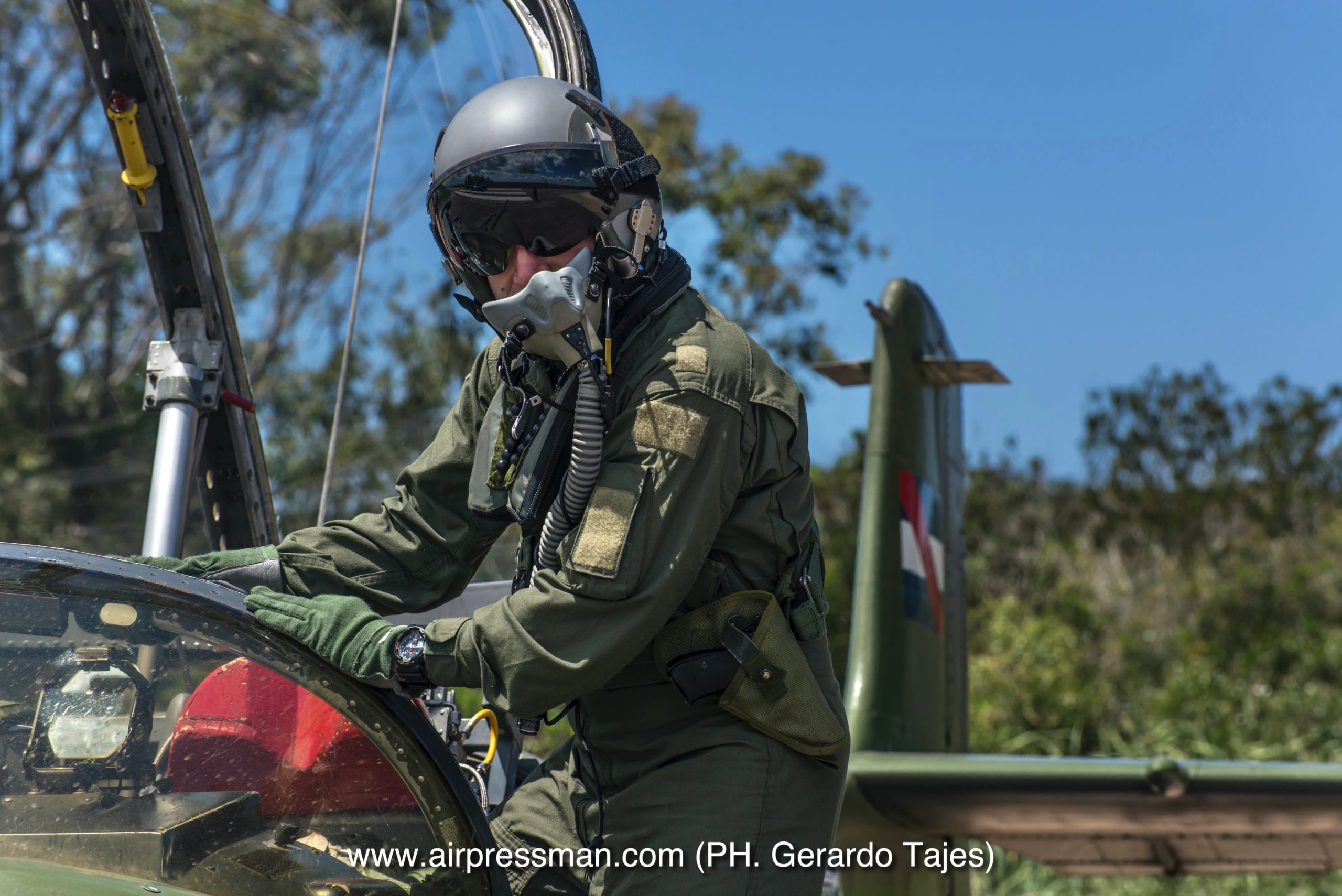
For this combined exercises the Escuadrón 2 appoints a forward air controller (FAC), a combat qualified Dragonfly pilot who in radio contact from the ground – and knowledgeable of the aircraft performance and weapons delivery envelope – provides orders and full guidance for CAS to the attacking aircraft. The army also provides their own FAU trained zone controller (controlador en zona) trained by the Escuadrón de Vuelo Avanzado- EVA (Advanced Flying Squadron – based in Durazno) who can only guide the Dragonflies, as he/she is unaware of the jets full performance facts.
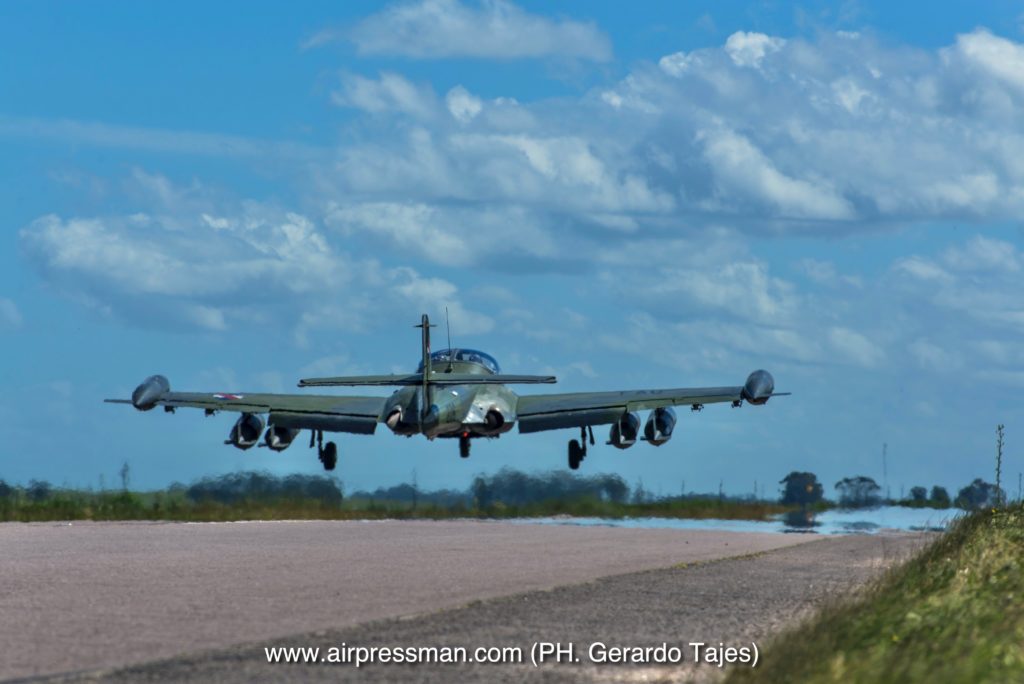
Combat air interceptions were conducted as well as air combat manoeuvring (ACM) Dragonfly against Dragonfly (previously conducted against the now retired FAU’s FMA IA-58A Pucará twin turboprop attack type). Search and rescue (SAR) and Combat SAR (CSAR) support for the Dragonfly deployment was provided by the FAU’s Escuadrón Aéreo No. 5 (helicópteros) (Air Squadron no. 5 – helicopters) with a Bell 212 Twin Huey (FAU 030) and one Bell UH-1H Huey (FAU 059). Downed pilot simulations were also conducted near La Paloma, with a Dragonfly pilot which after “bailing out” would have to walk to a secure location to be picked up by friendly forces. Once in place the pilot would select a safe landing zone (LZ), for the helicopters. The FAU Escuadrón 5 with ample experience in overseas United Nations (UN) missions, has conducted SAR and CSAR missions in Ethiopia, Eritrea and presently at the Democratic Republic of Congo, where two Bell 212s are posted. These operations are performed with a minimum of two aircraft, the Bell 212 being used to collect the pilot and the Huey as a gunship escort, armed with two 7.62mm or .50 guns, one fitted at either side. The Bell 212 in this case – would be crewed by two pilots, engineer, and two “Rescatistas” (Pararescue – PJ/ Para-jumpers).

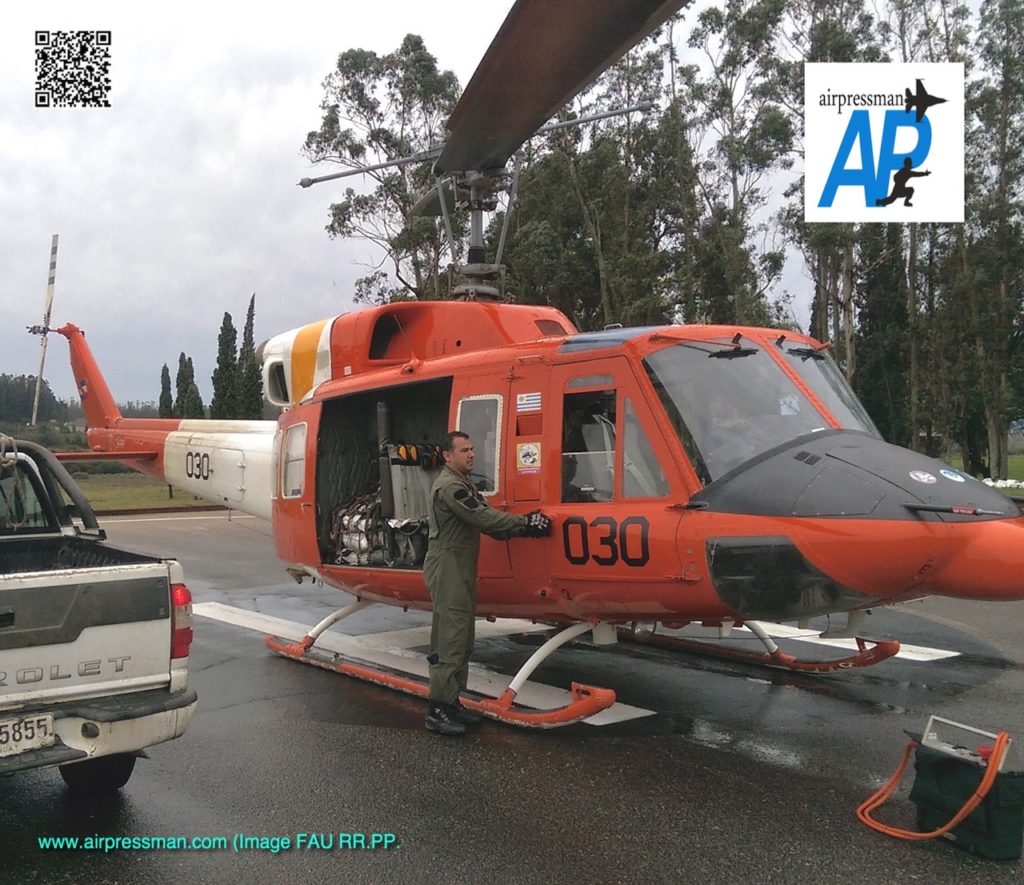
Overhead the rescue helicopters, the Dragonflies conducted defensive air patrols, in a racetrack pattern; however the pattern and heading could change if a ground threat towards the jets was detected or to avoid disclosure of the probable helicopters position to an enemy ground observer. Once in contact with the downed pilot, the Isolated Personal Report (ISOPREP) protocol was followed by the PJs to verify the pilot. This report, completed by all military staff before deployment to potentially hostile areas, contains full personal details and four self generated secret questions, that would have to be answered correctly whilst being rescued. CSAR crew carry the downed pilot ISOPREP details, to ensure they collect a friend instead of a foe. Failure to reply correctly, would mean for the pilot to be handcuffed and taken back to base for interrogation.


In all, 30 hours were flown and 10,000imp gal (45.000lit) of JP1(Avtur) fuel consumed by the Dragonfly fleet. The old Cessna jets consume an average of 330imp gal/h (1500lit/h). Major Bruno reported to the author that he was satisfied with the safe and successful completion of the deployment. The performance of the whole team, whilst operating away from base – sleeping in military tents and the nearby 18th century army managed fortress of Santa Teresa – was exemplary. Pilots new to the Dragonfly flew initial missions with instructors as to familiarize themselves with the narrower “runway” and local conditions – like strong mechanical turbulence generated by the prevailing Atlantic sea breeze striking a forest south of the road – and geography; and operated as aircraft commander in later ones with minimum supervision.

Escuadrón 2 maintenance engineers (Aerotécnicos) do wonders to keep the Dragonfly fleet flying 41 years after the arrival of the first batch of eight aircraft in 1976. Of great concern – at the time of this deployment – was the soon to be depleted stocks of the Weber ejection seats cartridges, there is no logistics chain for them as the seat production has long stopped and it is estimated that cartridges will run out during 2018.
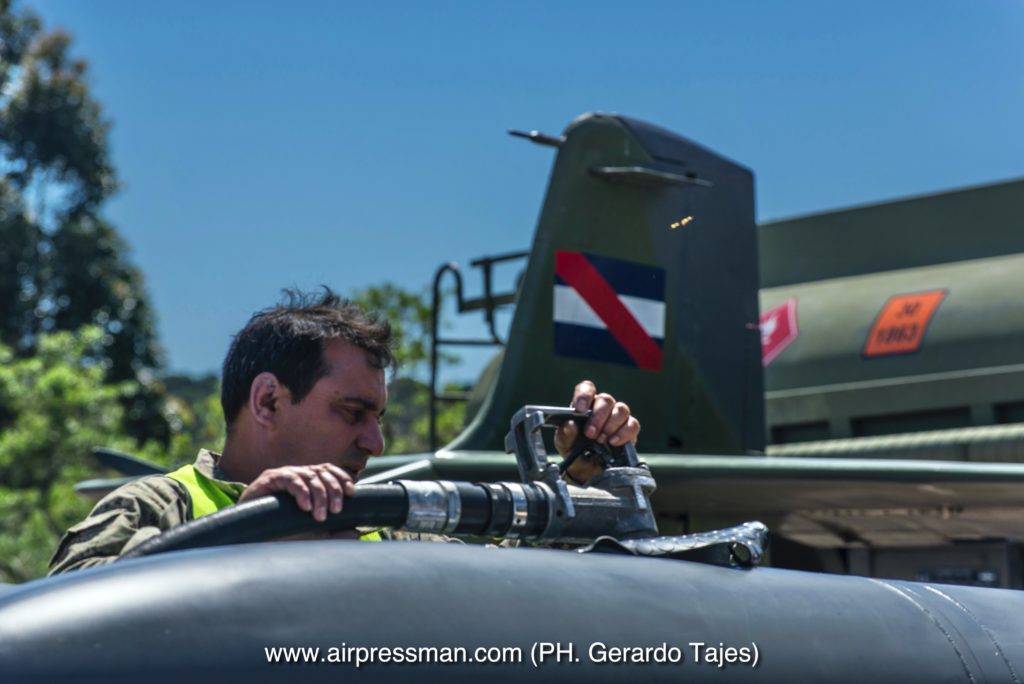
What’s next? New ejection seats and LIFT?
Since the article was written in late 2017, some important changes occurred in Uruguay which are relevant to our story. A new government took office in March 2020 with different ideas related to defence matters. The poor situation of the nation’s combat aviation must be improved urgently. Their road map is based on an strategic plan until 2040 for asset renewal, with the intention to achieve the necessary capacities to meet national requirements. In this sense, a single combat squadron equipped with a Lead-In Fighter Trainer (LIFT) type aircraft is on the cards.

Also during 2017 the FAU selected the Martin Baker (MB) model Mk-8 (AU8LD) ejection seat to equip their fleet Dragonfly jets. An order for 12 seats to be installed on six of the two-seater aircraft was placed.

Negotiations began during March 2017 when FAU personnel visited the MBA (Martin Baker Argentina branch) located at the Fuerza Aérea Argentina (FAA-Argentinian Air Force) Área Material Rio IV in Córdoba. An installation trial was completed during March 2017 at a cost of £168.000 (US$ 225.000). Authorisation for the acquisition was granted by the Uruguayan Government in November 2017 (a month before our described squadron deployment) the total cost of the transaction being £3.6 million (US$4.8million) payable in three installments.
LEFT: Martin Baker MK-8 (PH. Martin Baker)
The seats were built by the British, Denham based, MB’s partner SICAMB of Latina, Lazio Region, Italy. Deliveries occurred in October of 2018 with the installation of the seats on the aircraft, carried out by MBA at the Dragonfly’s home in Durazno. The MK-8 offers a far safer ejection envelope than the old Weber seat.

Pilots from Escuadrón 2 and 1 (the latter now grounded since the Pucará fleet was withdrawn from service and keep current by flying Pilatus PC-7Us) visited Nanchang in China in August 2016, to assess and fly the Hongdu L-15B Lead-In Fighter Trainer (LIFT) jet. The aircraft possess passive electronically array (PESA) radar, IFF, ECM and radar warning receivers. On previous years the force analysed the russian Yakolev YAK-130 without, perhaps a more apt aircraft for operating conditions in Uruguay.

Uruguay’s main air threat comes from illicit flights crossing the country to and from its giant neighbours –Brazil and Argentina – therefore Escuadrón 2 main role it’s one of aerial police. Without the Pucará (see our feature “Uruguayan Drugbuster”) amongst its ranks – a type often tasked with intercepting low performance illicit aircraft – and with a handful of Swiss built armed PC-7U turbo trainers in service, the ancient Dragonfly fleet is stretched to its limits for these assignments. FAU high command has insisted that if new aircraft are purchased for its fighter/attack squadrons, it must have a look down radar, seen by pilots as substantial tool during the final moments on air interception, whilst approaching a target, following the initial guidance and vectors to the target provided by the Lanza 3D radars of the AOC.

The FAU would require 8 to 12 jets to replace the Dragonfly – and possibly and ideally the Pucará – unifying Escuadrón 2 & 1 into a single attack/fighter unit. This hi-tech acquisition will mean a major technological step forward to the service and the perfect partner to the state of the art Lanza 3D radars (to be upgraded during 2018) finally bringing the FAU into the 21st century.


Left: Cover of Air International, January 2018 (UK’s Key Publishing) where the feature “Highwayman” was first printed.
**Note: The acronym (Av.) after a FAU pilot’s rank, stands for Aviador (Aviator)**

.png)
.png)
